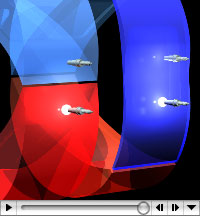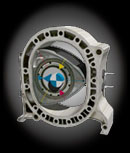|
|
|
 |
|
|
|
 |
|
|
Rotary Engine 101: Ignition
|
|
|
|
Since the working chambers of each rotor fire in the same geographic location in the engine, only one set of spark plugs are needed per rotor housing. Due to the complexities of combusting a long chamber, two spark plugs are used in each housing. The lower one is called the "leading" spark plug, while the top one is called the "trailing" spark plug. Additionally, the front rotor housing is denoted as "1" and the rear rotor housing is denoted as "2". So, in short hand, the Trailing (top) plug on the front rotor housing is referred to as "T1", the Leading (lower) plug in the front rotor housing is referred to as "L1", and so forth. |
|
|
|
As the working chamber approaches Top Dead Center (TDC), the leading plug fires first, starting the ignition of the air-fuel mixture and contributing most to the generation of power. The trailing plug typically fires 10 to 15 degrees later and effectively completes the combustion of the remaining air-fuel mixture above the minor axis of the trochoid housing. Additionally, the leading plug fires a second time late in the power stroke, which is called a "wastespark". The wastespark is done to simplify the ignition system by allowing both leading plugs to be fired "on the same channel" (one coil, one signal) . Basically, both leading plugs always fire at the same time, so there is an extra (wasted) spark during the power stroke. The trailing plugs cannot be fired in wastespark mode due to the location of the plug above the minor axis -- when one trailing plug is firing, the other trailing plug is already in the next working chamber, where it would preignite the incoming air-fuel mixture. |
|
|
 |
|
|
Click image to view Quicktime animation -- 1 mb.
Note: the Leading (lower) plugs always fire simultaneously, while the Trailing (top) plugs fire independantly of each other.
|
|
|
| As you may have figured out, there are three discrete ignition "channels" -- one for the leading plugs and two separate ones for the trailing plugs. Early, distributor-controlled, rotary engines could get away with only two coils (one each for leading and trailing ignitions) due to the coil engery being redirected through the distributor to the appropriate trailing spark plug. Later, crank angle sensor-controlled, rotary engines (starting with the 2nd generation RX-7) require three separate coils due to the direct-fire setup. |
|
|
|
|
|
|
|
|
|
|
|
TIMING COMMENTS
Timing of the engine, be it ignition or intake/exhaust porting, is based on degrees of eccentric shaft rotation, rather than rotor rotation. The difference is that the rotor rotates at one third the forward rate of the eccentric shaft, so three degrees of eccentric shaft rotation translates to one degree of rotor rotation relative to the housing. It is also helpful to remember that each working chamber of a rotary engine has two Top Dead Centers (minimum chamber volume) and two Bottom Dead Centers (maximum chamber volume). Timing is usually expressed relative to either TDC or BDC, in degrees of eccentric shaft rotation Before or After those critical points. 5° BTDC, for example, means the event in question occurs 5° of eccentric shaft rotation Before the applicable Top Dead Center of a given working chamber. Further, one may refer to Advancing the timing, which simply means to increase degrees BTDC or BBDC, or decrease degrees ATDC or ABDC. Retarding the timing is the converse. Relative measurements such as these are difficult to grasp at first, but they make the most sense in application.
|
|
|
|
|
 |
|
|
[ HOME ] [ ANIMATIONS | RE 101 | ADVANCED | ENGINE GUIDE | RESOURCES ]
|
|
|
|
Copyright © 2001 by Blake Qualley. All Rights Reserved.
|
|
|
|
|
|
|
|
|
|
|
|
|
|
|
|
|



